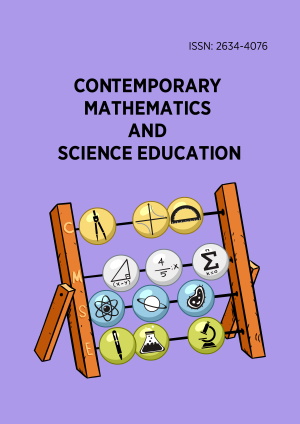Research Article
The Discovery Approach Strategy in Solving Hard Mathematics Problems: A Case Study
More Detail
1 AL-Qasemi Academic, College of Education, Baqa Elgarbeia, 30100, ISRAEL2 The Academic Arab College, Haifa. 32623, ISRAEL* Corresponding Author
Contemporary Mathematics and Science Education, 1(1), January 2020, ep20004, https://doi.org/10.30935/conmaths/8449
Published: 04 August 2020
OPEN ACCESS 1305 Views 1755 Downloads
ABSTRACT
Four goals of this report: (a) To examine whether Mathematics Pre-Service Teachers (MPSTs) have the ability to solve correctly hard mathematical problems taken from the International Mathematics Olympiad (IMO), (b) To examine the main strategies used by MPSTs to solve these problems, (c) To examine whether MPSTs’ attitudes and beliefs about mathematics teaching and learning, could be influenced by a course in “Math Problem Solving Seminar”, and (d) what strategies might promote these beliefs. This has direct implications for the teaching and learning of mathematics. To answer these questions, sample that included a class of 36 students participate in this study which included two groups 14 excellent and 22 ordinary MPSTs. All participants took the same above course and worked in pairs (17) or individually (2). The participants choose a problem from a questionnaire which included 19 IMO problems. All the participants presented their solutions in front of the other students. Our case study- Samia’s (female) solution to “The napkins problem (IMO 2011, C7)”. The results showed that all students in our example have the ability to solve hard mathematical problems taken from the IMO. The results showed as well, that the Discovery Approach Strategy together with the Visual Approach Strategy was found to contribute positively to the solution of her problem (need to get a conjecture without the proof). In the process of solving these problems, the MPSTs reorganized their information and reconstructed their arguments. Samia supported this by using The Discovery Approach Strategy. This result is in partial accordance with the study of Tripathi (2009).
The results of the semi–constructed interview showed, that the attitudes and beliefs were positively influenced by the lecturer “ An amazing and professional lecturer can contribute positively to MPSTs’ solving of difficult IMO problems via his/her direction, enthusiasm, general encouragement, setting up of challenges and encouragement of creativity, motivation, self-confidence and mathematical thinking”.
We believe that training by professional mathematical teachers, using The Discovery Approach Strategy, to solve difficult mathematical problems contributes positively to MPSTs’ cognitive development, and as a direct implication, will contribute positively to the cognitive development of their students.
The results of the semi–constructed interview showed, that the attitudes and beliefs were positively influenced by the lecturer “ An amazing and professional lecturer can contribute positively to MPSTs’ solving of difficult IMO problems via his/her direction, enthusiasm, general encouragement, setting up of challenges and encouragement of creativity, motivation, self-confidence and mathematical thinking”.
We believe that training by professional mathematical teachers, using The Discovery Approach Strategy, to solve difficult mathematical problems contributes positively to MPSTs’ cognitive development, and as a direct implication, will contribute positively to the cognitive development of their students.
CITATION (APA)
Rasslan, S., Arisha Haj Ihia, H., Haj-Yahia, S., & Rasslan-Sharif, A. (2020). The Discovery Approach Strategy in Solving Hard Mathematics Problems: A Case Study. Contemporary Mathematics and Science Education, 1(1), ep20004. https://doi.org/10.30935/conmaths/8449
REFERENCES
- Boeckmann, H. (1971). The Discovery Approach Strategy for Mathematics Teachers. School science and Mathematics, 71(1), 3-6. https://doi.org/10.1111/j.1949-8594.1971.tb09833.x
- Cheung, P. H. (Link). Problem-solving strategies: Research findings from mathematics Olympiads. Department of Curriculum Studies. The University of Hong Kong, p. 80. Retrieved from http://sms.math.nus.edu.sg/smsmedley/Vol-20-2/Problem-solving%20strategies%20-%20research%20findings%20from%20Mathematics%20Olympiad(PH%20Cheung).pdf
- Dewey, J. (1933). How we think: A restatement of the relation of reflective thinking to the educational process. Boston, MA: D.C. Heath and Co.
- Lester, F., & Charles, R. I. (Eds.) (2003). Teaching mathematics through problem solving: Pre- K- grade. Reston, VA: National Council for Teachers of Mathematics.
- National Council for Teachers of Mathematics (2000). Principles and standards for school mathematics. Reston, VA: National Council for Teachers of Mathematics.
- Polya, G. (1945; 2nd edition, 1957). How to solve it. Princeton, NJ: Princeton University Press.
- Polya, G. (1981). Mathematical discovery: On understanding, learning and teaching problem solving (Combined ed.). New York: John Wiley and Sons.
- Schoenfeld, A. H. (1992). Learning to think mathematically: Problem solving, metacognition, and sense making in mathematics. In Grouws, D. A. (Ed.), Handbook of research on mathematics teaching and learning (pp. 334-370). New York: Macmillan.
- Schroeder, T. L., & Lester, F. K. (1989). Developing understanding in mathematics via problem solving. In Trafton, P. R. (Ed.), New directions for elementary school mathematics, 1989 Yearbook of the NCTM (pp. 31-42). Reston, VA: National Council for Teachers of Mathematics. https://doi.org/10.1080/00220671.1945.10881369
- Selden, J., & Selden, A. (1995). Unpacking the logic of mathematical statements. Educational Studies in Mathematics, 29(2), 123-151. https://doi.org/10.1007/BF01274210
- Tripathi, P. N. (2009). Problem solving in mathematics: A tool for cognitive development. In Subramaniam, K. & Mazumdar, A. (Eds.), International Conference to Review Research in Science, Technology and Mathematics Education. Mumbai. India.
- Weber, K. (2008). Mathematicians’ validation of proofs. Journal for Research in Mathematics Education, 39(4), 431-459. Retrieved from http://www.jstor.org/stable/40539306
- Wheatley, G. H. (1992). The role of reflection in mathematics. Educational Studies in Mathematics, 23(5), 529-541. https://doi.org/10.1007/BF00571471
- Winkler, P. (2006). The IMO compendium: A collection of problems suggested for the International Mathematical Olympiads: 1959–2004. Springer Science + Business Media, Inc. https://doi.org/10. 1007/978-1-4419-9854-5

 The articles published in this journal are licensed under the CC-BY Creative Commons Attribution International License.
The articles published in this journal are licensed under the CC-BY Creative Commons Attribution International License.